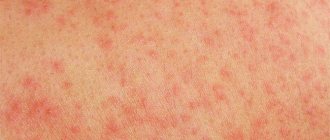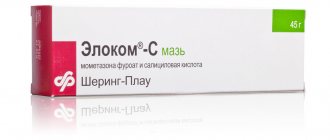Last update: 02/21/2021
Allergic reactions often cause various skin manifestations - rash, redness, irritation or swelling. Allergic dermatitis can often be difficult to distinguish from other skin conditions, such as infections or hives. Allergies are especially often confused with prickly heat, which occurs due to poor hygiene or temperature conditions.
What is the difference between prickly heat and allergies and how to determine which disease a child or an adult is suffering from? In order to answer this question, it is necessary to know the causes and symptoms of each disease and the characteristics of their course. In addition, the photos of heat rash and allergies presented on this page will help you.
Causes and symptoms of allergies
Many different factors can cause an allergic reaction - food, household chemicals, animal hair and pollen, fabrics, medications and even ultraviolet radiation. Sometimes even this knowledge is enough to distinguish allergies from prickly heat. If you've recently made changes to your usual diet, started taking new medications, or changed brands of laundry detergent, these factors are likely to be the cause of your breakouts. However, allergies can also arise unexpectedly - for example, if you have never previously noticed a negative reaction of the body to dog hair, and have only recently encountered this problem. In this case, special tests can help - they will not only help establish the presence of an atypical reaction to certain irritants, but will also help identify a specific allergen.
Usually, to get rid of the symptoms of prickly heat, it is enough to eliminate the factors that cause waterlogging and contamination of the skin - most often this is a lack of hygiene, poor ventilation of the skin due to clothing, or staying in hot and poorly ventilated rooms. In most cases, symptoms quickly disappear after this. An allergic rash is much more persistent: it is difficult to treat and does not always go away even after eliminating contact with the allergen.
Why does the disease occur?
The essence of the problem is local overheating of the skin, as a result of which excess secretion from the sweat glands provokes an inflammatory process. This is possible in the following situations:
- excessively warm clothing for the child;
- tight wrapping;
- violation of child skin hygiene;
- high ambient temperature;
- lack of ventilation in the room.
As a result, stagnation of secretion is formed in the sweat glands, which creates the preconditions for infection. The surrounding skin becomes sharply irritated and a typical rash appears.
Causes and symptoms of prickly heat
Heat rash usually occurs when your skin becomes overheated and too wet, for example if you wear clothes that are too tight or are in a particularly hot and humid climate. Heat rash in newborns and infants often occurs when swaddling is too tight or low-quality diapers are used. This leads to one of the main differences between prickly heat and allergies - the limited localization of the rash. Typically, the symptoms of this disease appear locally - where clothing hides the skin, on the elbows or knees, in the area of skin or fat folds, under the hair. Allergy can affect both small areas of the skin and the entire surface of the body, since it is a systemic reaction of the body. In addition, the development of heat rash is often preceded by skin irritation - for example, friction from a tight collar or scarf.
The symptoms of the two diseases are very similar: the appearance of a small papular and/or vesicular rash. Most often, the affected skin turns red and swollen, becomes sensitive and irritated.
What does miliaria look like in newborns?
Miliaria, or the colloquial version of “sweet spot”, is a non-contagious and harmless, but unpleasant skin disease for the baby. It manifests itself in different ways. Depending on the nature of the rash and the depth of skin damage, three types of prickly heat are distinguished:
- Crystalline - transparent bubbles on the neck, head, shoulders. They burst easily, but do not cause inflammation and do not bother the child. This type of prickly heat goes away in a few days with good care.
- Miliaria rubra is a small red rash. The skin underneath may also be red and swollen. Miliaria rubra affects the deeper layers, so it can be accompanied by pain and itching. Against this background, an increase in temperature is possible. Most often, this heat rash occurs in the armpits, groin, and neck folds of the baby. The rash can last up to two weeks.
- Miliaria profunda - dense, flesh-colored bumps. Without treatment, it can cause complications due to the addition of secondary infections, but this type of prickly heat practically does not occur in newborns; it usually occurs in adolescents and adults.
Treatment of diseases
Each of these diseases requires its own approach to treatment, but the basis of therapy is the elimination of factors that cause skin irritation. In the case of allergies, anti-inflammatory drugs (local, including hormonal) can be an effective remedy, as well as desensitization - a gradual decrease in sensitivity to the allergen. Miliaria usually does not require special treatment, unless it is caused by systemic disorders in the endocrine, nervous or cardiovascular systems.
In order to get rid of the most unpleasant symptoms of the disease, you should use special cosmetics, in particular La-Cri products. They do not contain substances that can cause an allergic reaction, and the main active ingredients in them are extracts of medicinal plants. La-Cri products are excellent for caring for irritated and painful skin in both adults and children.
How to treat heat rash in newborns
The best treatment is prevention. To prevent heat rash from occurring, try to maintain the temperature in the apartment no higher than 22 degrees, regularly ventilate the baby’s room, and dress him according to the weather in loose clothing made from natural fabrics. At home in the heat, do not put on diapers for your baby, or at least change them promptly (once every 3 hours, regardless of how full they are). When changing, be sure to wash your baby and leave him to wallow without a diaper for 10-15 minutes so that the skin dries and ventilates. Do not apply greasy creams or cosmetic oils to your child’s skin in hot weather.
It is important!
If prickly heat has already appeared, then all of the above measures will also be relevant.
The task of parents is to keep the skin clean, provide air access to it, and prevent overheating. Usually this is enough for prickly heat to go away on its own in 3-7 days. If the rashes do not decrease or even become stronger, then pharmaceuticals will be required for treatment. But they can only be prescribed by a doctor after examining the child. Depending on the nature of the rash, the pediatrician will recommend antiseptics, products with dexpanthenol, zinc oxide or glucocorticosteroids.
Clinical researches
Clinical studies have proven the effectiveness, safety and tolerability of the products. The products are suitable for daily care of children's skin with mild to moderate forms of atopic dermatitis and during remission, accompanied by a decrease in the quality of life of patients.
Sources:
- Sukolin Gennady Ivanovich, Clinical dermatology. A short guide to the diagnosis and treatment of dermatoses, publishing house: Notabene, 2017
- Pankratov Valentin Gavrilovich, Pankratov Oleg Valentinovich, Infectious dermatology in the practice of primary care physicians, New Knowledge Publishing House, 2015
- Mancini A. J., Krouchuk D. P., Pediatric dermatology. Publisher: Practical Medicine, Directory, 2018
- Kildiyarova Rita Rafgatovna, Pediatrician for every day. Guide for doctors, publishing house GEOTAR-Media, 2021
Photos of heat rash
Photo album on the diseaseDoes your child need specialist help?
You can make an appointment with a doctor by phone
8-(4822)-33-00-33
or using the online registration system on the website
To make an appointment with a doctor
Read also: Vegetative-vascular dystonia in children
Miliaria rubra is a more severe lesion, often accompanied by infection. The skin of the back, axillary area, and less often the limbs suffers. If prickly heat forms in children, the symptoms are as follows:
- sharply hyperemic blisters located randomly on the surface of the skin;
- the background of the skin is dim red;
- there is no merging of elements;
- subjective - itching is possible;
- upon contact - pain;
- some vesicles have no contents and are identified by palpation as small nodes;
- In conditions of high humidity, symptoms can sharply intensify, causing anxiety to the child.
Papular miliaria is a variant of deep skin lesions. Occurs in children of older age groups. Associated with prolonged irritation of the sweat glands, as a result of which initial atrophic processes are formed and the skin becomes thinner. Symptoms are typical:
- papules up to 3 mm, the skin is completely covered with them;
- external background - pale reddish;
- palpation - dryness and slight peeling;
- infection is often associated with the development of pustular processes;
- When environmental conditions improve, all elements can quickly disappear.
Symptoms of the disease can significantly worsen the child’s condition when an infection occurs. It looks like limited pustular elements against a painful background of prickly heat. With the crystalline variant, this is very rare, with the rest, it is a fairly typical complication. There is an increase in temperature, the child becomes lethargic and may refuse to eat. Delay in such a situation is unacceptable, since the skin is richly supplied with blood, and septic lesions may occur in other organs.
Polina Vasilyeva
dermatologist
| Rashes can be treated with products containing zinc oxide (sudocrem), or diaper cream, powder. If you are concerned about itching, a cream with dexapanthenol (“Bepanten”, “Bepanten plus”, “Cicaplast”) or soothing creams that are sold in pharmacies will help. The products “Drapolen”, “Bepanten”, “Desitin” - their It is recommended to apply a thin layer and do not put on the diaper until completely absorbed. |
The essence of the problem
Miliaria refers to a specific variant of dermatitis that manifests itself against the background of excessive sweating. “Miliaria is an inflammatory skin disease in which the sebaceous duct becomes blocked. All the sebum against the background of such a blockage remains in it and leads to inflammation,” says allergist-immunologist Anna Shulyaeva .
The main reason for the development of prickly heat is an increase in temperature, for example, on the street and increased sweating. In addition, it can be a consequence of poor hygiene, against the background of which malfunctions and blockages in the functioning of the sebaceous glands occur. Tight clothing made from non-breathable materials also has a negative impact.
Fifth disease in children. What is it and what should you be afraid of? More details
Rash due to infectious diseases
A rash in infectious diseases is accompanied by enlarged lymph nodes, weakness, fatigue, nausea and diarrhea, and high fever. The shape and location of the rash depends on the type of infection that caused the rash.
Diseases accompanied by skin rashes:
- Measles. Rashes in the form of papules appear on the 3-4th day behind the ears, in the area of the bridge of the nose. And very quickly the rash spreads to the entire face. Then it moves to the upper back, chest, and lastly to the feet and hands.
- Rubella. The rash is small-spotted, pale pink. Localized on the skin of the buttocks in the bends of the elbows and knees. On the second day it covers the surface of the body and limbs.
- Scarlet fever. The rash is continuous in the form of redness from red dots. At first the rash is bright, then fades and then turns brownish. First the face is covered, then the neck, chest, and upper back. And then - on the thighs and forearms.
- Chicken pox. A very contagious disease with the appearance of vesicles on the scalp, in the groin area, and throughout the body, except the palms and feet.
- Herpes. The rash is small with liquid inside. Very painful. It is most often formed on the mucous membranes of the lips, nose, and genitals. Accompanied by itching and burning.
There are many other infectious diseases with rashes on the body. Among them are meningitis, mononucleosis, pneumonia. The disease occurs with obvious symptoms of general intoxication of the body.
Methods for diagnosing skin diseases:
- Diagnosis of skin diseases
- Diagnosis of skin diseases at home
- Diagnosis of allergic skin diseases
- Diagnosis of bacterial skin diseases
- Diagnosis of viral skin diseases
- Diagnosis of hair diseases
- Diagnosis of nail diseases
- Diagnosis of skin tumors
- Skin scraping
- Blisters on the skin
- Dermatoscopy
- Demodex tests
- Diagnosis of sexually transmitted infections
- Mushroom tests
- Skin scraping
Treatment of prickly heat in children
With proper care of your child's skin, the symptoms of prickly heat disappear within 2 to 3 days. However, if the child’s condition worsens and redness appears, which indicates a bacterial infection, parents should immediately seek medical help.
Success in the treatment of prickly heat depends on proper hygiene measures:
- Maintain optimal air temperature (20 - 220C) and humidity (45 - 60%) in the children's room. Constantly (2 - 3 times a day) ventilate it. The side walls of the crib must allow air to pass through.
- Avoid overly wrapping your child. Choose the right clothes for your baby.
- Every day, bathe the child in water with the addition of decoctions of string, chamomile, calendula or yarrow, or in a weak solution of potassium permanganate. Use detergents (baby soap) no more than 2 times a week and in small quantities. After bathing, you should dry your skin well, especially in the fold areas, but do not wipe it, but blot it. Powdering should be done with indifferent baby powders.
- Do not use low-quality children's cosmetics.
- Do not use low-quality diapers. Replace them regularly (every 3 hours and after bowel movements). After each bowel movement, the child should be washed under running water. When changing diapers or nappies, use air baths.
Polina Vasilyeva
dermatologist
| This disease most often occurs in young children, since their thermoregulation nerve centers are still imperfect and almost do not function. Sweating develops during the first two years of a child's life. Due to functional immaturity and a number of other factors, the sweat glands become blocked and a rash forms on the skin - miliaria. Factors influencing its appearance include, for example, incorrectly selected diapers, excessive wrapping of young children, lack or insufficiency of air baths, and much more. |
When and which doctor to contact
The patient copes with the first stage of prickly heat on his own. If severe swelling, crusts and pustules appear, the help of a dermatologist is required. After communicating with the patient, studying his medical record, and external examination, the doctor determines the cause of the condition and suggests measures to eliminate it. You may need to donate blood for a general analysis or to determine hormone levels.
The underlying disease is treated simultaneously with the elimination of signs of prickly heat. Medicines are prescribed by a doctor. Folk remedies are also used after its approval. If you are obese, you may need the help of a nutritionist. If the disease is associated with ovarian dysfunction during menopause, consultation with a gynecologist is advisable. Self-medication often causes serious complications, defects on the skin of the face and other parts of the body.
Localization of the problem
Most often, prickly heat affects the following areas of the body:
- the area called natural folds, that is, the armpits, groin, knees and elbows;
- area under the breasts in women;
- if a person has thick hair, then prickly heat may develop in the area behind the ears;
- with excessive fullness of the legs, prickly heat appears on the inside of the thighs;
- an area of the body that is constantly under clothing or some additional accessories, such as bandages.
Diagnostics
A pediatric dermatologist or pediatrician will examine the child and interview the parents, as well as a series of studies to rule out dermatitis, chickenpox, scarlet fever and many other diseases with similar symptoms. Most often, a visual examination is enough, but tests (scraping) may be required to help identify the causative agent of a secondary infection (if one is observed). A general and biochemical blood test is often done, as well as an analysis of the contents of the vesicles - it all depends on the recommendations of the attending physician.








